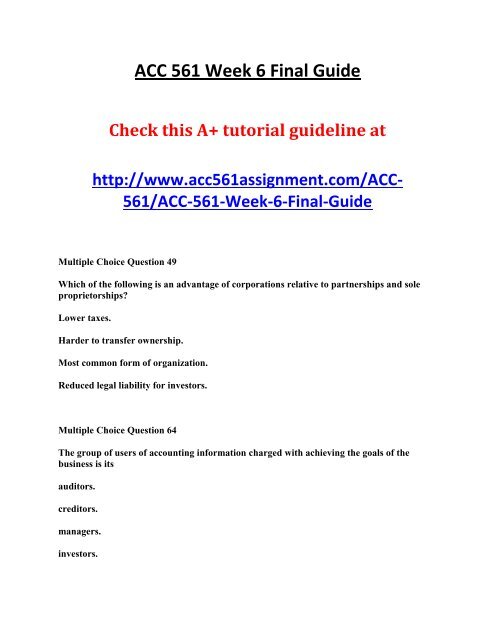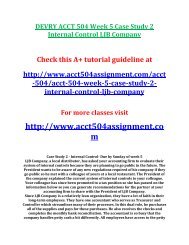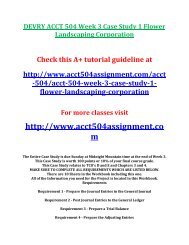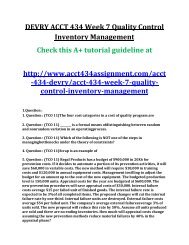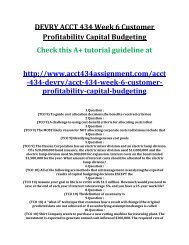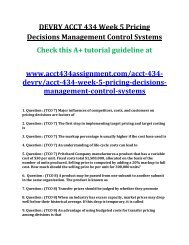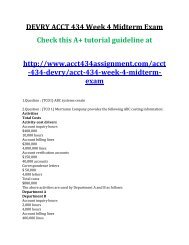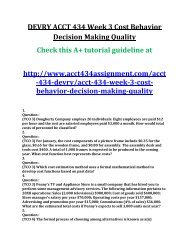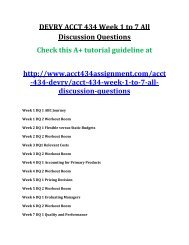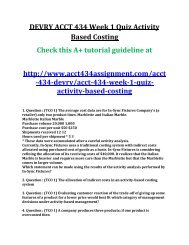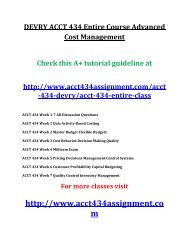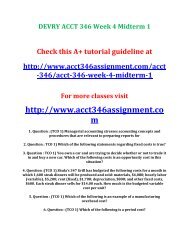ACC 561 Week 6 Final Guide
uop acc 561 week 6 assignment practice quiz,uop acc 561 week 6 assignment wileyplus,uop acc 561 week 6 final guide,uop acc 561 week 6 learning team reflection,uop acc 561 new,acc 561 new,uop acc 561 new week 6 tutorial,acc 561 new week 6 assignment,uop acc 561 new week 6 help
uop acc 561 week 6 assignment practice quiz,uop acc 561 week 6 assignment wileyplus,uop acc 561 week 6 final guide,uop acc 561 week 6 learning team reflection,uop acc 561 new,acc 561 new,uop acc 561 new week 6 tutorial,acc 561 new week 6 assignment,uop acc 561 new week 6 help
Create successful ePaper yourself
Turn your PDF publications into a flip-book with our unique Google optimized e-Paper software.
<strong>ACC</strong> <strong>561</strong> <strong>Week</strong> 6 <strong>Final</strong> <strong>Guide</strong><br />
Check this A+ tutorial guideline at<br />
http://www.acc<strong>561</strong>assignment.com/<strong>ACC</strong>-<br />
<strong>561</strong>/<strong>ACC</strong>-<strong>561</strong>-<strong>Week</strong>-6-<strong>Final</strong>-<strong>Guide</strong><br />
Multiple Choice Question 49<br />
Which of the following is an advantage of corporations relative to partnerships and sole<br />
proprietorships?<br />
Lower taxes.<br />
Harder to transfer ownership.<br />
Most common form of organization.<br />
Reduced legal liability for investors.<br />
Multiple Choice Question 64<br />
The group of users of accounting information charged with achieving the goals of the<br />
business is its<br />
auditors.<br />
creditors.<br />
managers.<br />
investors.
Multiple Choice Question 110<br />
Which of the following financial statements is concerned with the company at a point in<br />
time?<br />
Entry field with correct answer<br />
Income statement.<br />
Balance sheet.<br />
Retained Earnings statement.<br />
Statement of cash flows.<br />
Multiple Choice Question 112<br />
An income statement<br />
presents the revenues and expenses for a specific period of time.<br />
summarizes the changes in retained earnings for a specific period of time.<br />
reports the assets, liabilities, and stockholders’ equity at a specific date.<br />
reports the changes in assets, liabilities, and stockholders’ equity over a period of time.<br />
Multiple Choice Question 118<br />
The most important information needed to determine if companies can pay their current<br />
obligations is the<br />
net income for this year.<br />
relationship between current assets and current liabilities.<br />
projected net income for next year.<br />
relationship between short-term and long-term liabilities.
Multiple Choice Question 124<br />
A liquidity ratio measures the<br />
short-term ability of a company to pay its maturing obligations and to meet unexpected<br />
needs for cash.<br />
percentage of total financing provided by creditors.<br />
income or operating success of a company over a period of time.<br />
ability of a company to survive over a long period of time.<br />
Multiple Choice Question 165<br />
The convention of consistency refers to consistent use of accounting principles<br />
throughout the accounting periods.<br />
among firms.<br />
within industries.<br />
among accounting periods.<br />
Multiple Choice Question 90<br />
Horizontal analysis is also known as<br />
common size analysis.<br />
linear analysis.<br />
vertical analysis.<br />
trend analysis.<br />
Multiple Choice Question 92<br />
Horizontal analysis is a technique for evaluating a series of financial statement data over a<br />
period of time
to determine which items are in error.<br />
that has been arranged from the highest number to the lowest number.<br />
to determine the amount and/or percentage increase or decrease that has taken place.<br />
that has been arranged from the lowest number to the highest number.<br />
Multiple Choice Question 111<br />
Vertical analysis is a technique that expresses each item in a financial statement<br />
as a percent of a base amount.<br />
in dollars and cents.<br />
starting with the highest value down to the lowest value.<br />
as a percent of the item in the previous year.<br />
Multiple Choice Question 41<br />
Process costing is used when<br />
the production process is continuous.<br />
costs are to be assigned to specific jobs.<br />
production is aimed at filling a specific customer order.<br />
dissimilar products are involved.<br />
Multiple Choice Question 43<br />
An important feature of a job order cost system is that each job<br />
must be similar to previous jobs completed.<br />
has its own distinguishing characteristics.
must be completed before a new job is accepted.<br />
consists of one unit of output.<br />
Multiple Choice Question 49<br />
In a process cost system, product costs are summarized:<br />
on job cost sheets.<br />
on production cost reports.<br />
when the products are sold.<br />
after each unit is produced.<br />
Multiple Choice Question 33<br />
An activity that has a direct cause-effect relationship with the resources consumed is a(n)<br />
overhead rate.<br />
product activity.<br />
cost driver.<br />
cost pool.<br />
Multiple Choice Question 40<br />
Activity-based costing<br />
allocates overhead to multiple activity cost pools, and it then assigns the activity cost pools<br />
to products and services by means of cost drivers.<br />
assigns activity cost pools to products and services, then allocates overhead back to the<br />
activity cost pools.<br />
accumulates overhead in one cost pool, then assigns the overhead to products and services<br />
by means of a cost driver.
allocates overhead directly to products and services based on activity levels.<br />
Multiple Choice Question 40<br />
A cost which remains constant per unit at various levels of activity is a<br />
mixed cost.<br />
fixed cost.<br />
manufacturing cost.<br />
variable cost.<br />
Multiple Choice Question 105<br />
The break-even point is where<br />
total sales equal total variable costs.<br />
total variable costs equal total fixed costs.<br />
total sales equal total fixed costs.<br />
contribution margin equals total fixed costs.<br />
Multiple Choice Question 109<br />
Fixed costs are $600,000 and the contribution margin per unit is $150. What is the breakeven<br />
point?<br />
$1,500,000<br />
$4,000,000<br />
1,500 units<br />
4,000 units
Multiple Choice Question 94<br />
When a company assigns the costs of direct materials, direct labor, and both variable and<br />
fixed manufacturing overhead to products, that company is using<br />
product costing.<br />
operations costing.<br />
absorption costing.<br />
variable costing.<br />
Multiple Choice Question 122<br />
If a division manager's compensation is based upon the division's net income, the manager<br />
may decide to meet the net income targets by increasing production when using<br />
variable costing, in order to increase net income.<br />
variable costing, in order to decrease net income.<br />
absorption costing, in order to increase net income.<br />
absorption costing, in order to decrease net income.<br />
Multiple Choice Question 50<br />
An unrealistic budget is more likely to result when it<br />
has been developed by all levels of management.<br />
has been developed in a bottom up fashion.<br />
has been developed in a top down fashion.<br />
is developed with performance appraisal usages in mind.<br />
Multiple Choice Question 39
A major element in budgetary control is<br />
the valuation of inventories.<br />
the preparation of long-term plans.<br />
approval of the budget by the stockholders.<br />
the comparison of actual results with planned objectives.<br />
Multiple Choice Question 43<br />
The purpose of the sales budget report is to<br />
control sales commissions.<br />
control selling expenses.<br />
determine whether income objectives are being met.<br />
determine whether sales goals are being met.<br />
Multiple Choice Question 89<br />
The accumulation of accounting data on the basis of the individual manager who has the<br />
authority to make day-to-day decisions about activities in an area is called<br />
flexible accounting.<br />
static reporting.<br />
responsibility accounting.<br />
master budgeting.<br />
Multiple Choice Question 142<br />
Variance reports are
(a) external financial reports.<br />
(b) SEC financial reports.<br />
(c) internal reports for management.<br />
(d) all of these.<br />
Multiple Choice Question 40<br />
Internal reports that review the actual impact of decisions are prepared by<br />
the controller.<br />
management accountants.<br />
factory workers.<br />
department heads.<br />
Multiple Choice Question 42<br />
The process of evaluating financial data that change under alternative courses of action is<br />
called<br />
cost-benefit analysis.<br />
contribution margin analysis.<br />
incremental analysis.<br />
double entry analysis.<br />
Multiple Choice Question 54<br />
Seasons Manufacturing manufactures a product with a unit variable cost of $100 and a<br />
unit sales price of $176. Fixed manufacturing costs were $480,000 when 10,000 units were<br />
produced and sold. The company has a one-time opportunity to sell an additional 1,000<br />
units at $140 each in a foreign market which would not affect its present sales. If the
company has sufficient capacity to produce the additional units, acceptance of the special<br />
order would affect net income as follows:<br />
Income would increase by $40,000.<br />
Income would decrease by $8,000.<br />
Income would increase by $140,000.<br />
Income would increase by $8,000.<br />
Multiple Choice Question 70<br />
Carter, Inc. can make 100 units of a necessary component part with the following costs:<br />
Direct Materials $120,000<br />
Direct Labor 20,000<br />
Variable Overhead 60,000<br />
Fixed Overhead 40,000<br />
If Carter can purchase the component externally for $220,000 and only $10,000 of the fixed<br />
costs can be avoided, what is the correct make-or-buy decision?<br />
Buy and save $30,000<br />
Make and save $10,000<br />
Buy and save $10,000<br />
Make and save $30,000<br />
Multiple Choice Question 84<br />
A company has a process that results in 15,000 pounds of Product A that can be sold for<br />
$16 per pound. An alternative would be to process Product A further at a cost of $200,000<br />
and then sell it for $28 per pound. Should management sell Product A now or should<br />
Product A be processed further and then sold? What is the effect of the action?<br />
Sell now, the company will be better off by $20,000.<br />
Sell now, the company will be better off by $200,000.
Process further, the company will be better off by $180,000.<br />
Process further, the company will be better off by $20,000.<br />
For more classes visit<br />
www.acc<strong>561</strong>assignment.com


